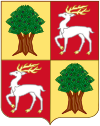Roncesvalles
| Roncesvalles | ||
|---|---|---|
| Municipality | ||
| Orreaga/Roncesvalles | ||
 |
||
|
||
| Location in Spain | ||
| Coordinates: 43°0′N 1°19′W / 43.000°N 1.317°W | ||
| Country | Spain | |
| Autonomous community | Navarre | |
| Province | Navarre | |
| Comarca | Auñamendi | |
| Judicial district | Aóiz | |
| Government | ||
| • Mayor | Luis Echeverría Echávarren | |
| Area | ||
| • Total | 15.1 km2 (5.8 sq mi) | |
| Elevation | 923 m (3,028 ft) | |
| Highest elevation | 1,564 m (5,131 ft) | |
| Lowest elevation | 910 m (2,990 ft) | |
| Population (2009) | ||
| • Total | 30 | |
| • Density | 2.0/km2 (5.1/sq mi) | |
| Demonym(s) | Orreagatarra | |
| Time zone | CET (UTC+1) | |
| • Summer (DST) | CEST (UTC+2) | |
| Postal code | 31650 | |
| Dialing code | 948 | |
| Website | Official website | |
Roncesvalles (Spanish pronunciation: [ronθezˈβaʎes]; Basque: Orreaga [oreaɣa], Aragonese: Ronzesbals [ronθesˈbals], Italian: Roncisvalle [rontʃizˈvalle], French: Roncevaux [ʁɔ̃s(ə)vo]) is a small village and municipality in Navarre, northern Spain. It is situated on the small river Urrobi at an altitude of some 900 metres in the Pyrenees, about 4 kilometres from the French frontier as the crow flies, or 21 kilometres by road.
Roncesvalles is famous in history and legend for the defeat of Charlemagne and the death of Roland in 778, during the battle of Roncevaux Pass, when Charlemagne's rear guard was destroyed by Basque tribes.
When a party of horsemen from the Kingdom of Navarre arrived at the Duchy of Burgundy in 1439 to negotiate Prince Charles of Navarre's marriage to Agnes of Cleves, the Duke of Burgundy's niece, the prior of Roncesvalles was their chief ambassador. He was described as a "noble knight".
...
Wikipedia


